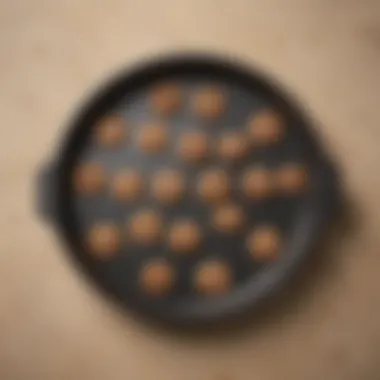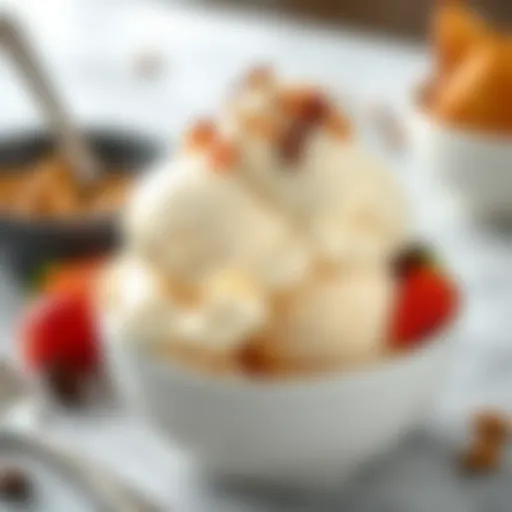Unlocking the Potential of a 4 Inch Round Baking Pan


Intro
The 4 inch round baking pan is often underestimated in its capability within the kitchen. Many may associate larger pans with more versatility or grandeur. However, the 4 inch variant brings a unique combination of precision and adaptability. As we delve into this article, we will explore its various aspects, specifically highlighting its significance in portion control, recipe customization, and experimental baking techniques. This information is geared towards food enthusiasts who appreciate detail and the science behind baking.
By understanding the utility of a 4 inch round baking pan, bakers of all skill levels can enhance their culinary projects and broaden their knowledge of baking tools. Let us now discuss some foundational recipes that fit perfectly within its confines.
Recipe Overview
Recipe Name and Description
One classic recipe that benefits from this size is the Mini Cheesecake. This dessert is smooth and creamy, making it an excellent choice for both individual servings and small gatherings. The 4 inch pan allows for control over portion sizes, ensuring no guest feels overwhelmed with large slices.
Cuisine Type
The Mini Cheesecake falls under American cuisine but also has roots in other culinary traditions. The simplicity of the recipe makes it adaptable to various influences and flavor profiles, expanding its appeal across different palates.
Ingredients List
Detailed Ingredient Breakdown
- For the crust:
- For the filling:
- 1 cup graham cracker crumbs
- 2 tablespoons sugar
- 4 tablespoons unsalted butter, melted
- 8 ounces cream cheese, softened
- 1/3 cup sugar
- 1 teaspoon vanilla extract
- 1 large egg
Substitutions for Dietary Needs
- Gluten-Free: Substitute graham cracker crumbs with gluten-free cookie crumbs.
- Vegan Option: Use nut-based cream cheese or tofu with a similar texture and replace egg with flaxseed meal mixed with water.
- No Sugar: For those watching sugar intake, you can use sugar substitutes like stevia or erythritol.
Understanding these components—how they can be customized—opens new avenues in baking. The traits of the 4 inch round baking pan allow bakers to experiment without the risk of excessive waste. This is ideal for those who enjoy creating new flavors or want to perfect a technique without committing to a larger batch.
Adapting your recipes for a 4 inch round baking pan can also encourage a more sustainable approach to baking, minimizing leftovers and maximizing creativity.
Prologue to the Inch Round Baking Pan
A 4 inch round baking pan is an essential kitchen tool that serves a multitude of purposes. Its size enables precision in baking that is often necessary for specialized recipes or portion control. As culinary experiments become increasingly popular, understanding the unique functions and characteristics of this pan can enhance both the baking experience and the final product. This section will dive into the definition and characteristics of the 4 inch round baking pan. It will also examine the material variations available, discussing how these options impact performance and suitability for different baking tasks.
Definition and Characteristics
The 4 inch round baking pan is defined by its compact, circular shape, making it ideal for smaller bakes. Typically made from materials like metal, glass, or silicone, these pans allow for even heat distribution, promoting consistent baking results. The characteristics of this pan vary slightly depending on the material, but generally, they provide good heat retention and can be used for various types of baked goods. From cakes to muffins, this pan can support multiple baking endeavors, making it versatile and practical. One key aspect to note is its size, which is particularly useful for individual servings, reducing waste, and making it easier to manage portion control.
Material Variations Available
Different baking pan materials offer distinct advantages, and understanding these differences can lead to better baking outcomes.
Metal
Metal pans, often made of aluminum or stainless steel, are popular among bakers for their excellent heat conductivity. They heat up quickly and evenly, resulting in a well-baked product. Notably, metal pans are durable and resistant to warping, which contributes to their longevity in the kitchen. However, they require careful greasing or the use of baking spray to ensure easy release of baked goods.
Glass
Glass baking pans offer a transparent choice that allows bakers to monitor the cooking process without removing items from the oven. They distribute heat evenly and retain warmth effectively. Glass is non-reactive, which means it does not alter the taste of food. This can be crucial when baking more delicate items, such as cheesecakes. However, glass pans are less robust compared to metal pans and may shatter under extreme temperature changes.
Silicone
Silicone pans have gained popularity due to their flexibility and easy release properties. Unlike metal or glass, silicone pans can tolerate a wide range of temperatures, making them suitable for both baking and freezing. This material is lightweight and can be easily stored in smaller spaces. However, the downsides include less effective heat distribution compared to metal or glass, which can lead to uneven baking if not monitored closely.


In summary, the 4 inch round baking pan is a multifaceted kitchen tool, and selecting the right material can significantly impact your baking results.
Historical Context
The 4 inch round baking pan has a storied history that plays a significant role in understanding its evolution and usage. Recognizing this historical context not only aids bakers in appreciating the design but also enhances their baking practices. Historical developments of baking tools reflect changing culinary trends and societal needs. As we delve deeper, it becomes evident how various cultural influences have impacted baking pan designs and their applications.
Evolution of Baking Pans
Baking pans have undergone remarkable changes from their rudimentary forms to the specialized implements we see today. The early baking vessels were primarily made from clay and used over open flames. With the advent of metalworking, pans made from iron and later aluminum became prevalent. These materials allowed for better heat distribution, essential for even baking.
The introduction of non-stick coatings in the late 20th century revolutionized baking, making it easier to release baked goods from pans. The 4 inch round variant, while perhaps less common than larger sizes, offers specific advantages in precision baking. For instance, its compact size is ideal for individual servings, appealing to both modern dietary preferences and the aesthetic of plated desserts. Understanding this evolution aids the baker in choosing the right materials and designs for individual needs.
Cultural Significance
Across various cultures, the significance of baking pans can be traced back to communal practices and culinary artistry. The smaller 4 inch round baking pan often signifies a shift towards personal-sized desserts in many regions. In many cultures, there is a strong emphasis on individual portions, reflecting modern lifestyles that favor moderation and personal choice over sharing larger items.
In addition, baking has been a method to showcase hospitality and community spirit in many cultures. The small, individual cakes created in a 4 inch pan can often serve at celebrations, from birthdays to weddings. The practicality of the pan and its cultural relevance allows it to transcend merely being a kitchen tool. In a way, it embodies the values of precision and personal touch in a world often leaning towards mass production.
"The history of baking pans tells a story of innovation, reflecting changes in societal needs and culinary preferences throughout time."
The importance of understanding the historical context of the 4 inch round baking pan lies not only in its practical applications but also in how it connects bakers to their culinary heritage. This connection can inspire creativity and encourage more deliberate choices in baking practices.
Functional Advantages
The 4 inch round baking pan presents several functional advantages that greatly enhance its usability in kitchens. Understanding these benefits is crucial for bakers who aim to hone their skills or seek to create effective and aesthetically pleasing desserts. Specifically, the size of this pan caters perfectly to individual servings, allows for precise portion control, and offers remarkable versatility in recipe adaptation.
Ideal for Individual Servings
One of the standout features of a 4 inch round baking pan is its ideal nature for individual servings. This size strikes a balance between providing enough dessert for enjoyment while also preventing waste. Single-serving desserts are increasingly popular. They cater to a variety of dietary preferences and allow for customizable flavors to suit personal tastes. Whether it is a mini cheesecake or a personal cake, the 4 inch pan helps bakers innovate while serving guests with something they can call their own.
Efficient Portion Control
Utilizing a 4 inch round pan gives bakers effective control when portioning out their baked goods. In an age where health consciousness is prevalent, controlling portion sizes becomes important. This small pan helps reduce the temptation for larger portion sizes that can lead to overeating. It also allows for balanced servings when hosting gatherings. Instead of cutting a larger cake, guests can enjoy neatly presented individual cakes, which can enhance the overall dining experience.
Versatility in Recipe Adaptation
The versatility of the 4 inch round baking pan extends to the adaptation of recipes, accommodating a wide array of baked goods. This adaptability is particularly beneficial for those looking to try new recipes or modify existing ones. By leveraging its small size, bakers can experiment.
Scaling Recipes
Scaling recipes for the 4 inch round pan can be an exciting aspect of baking. It requires understanding how to adjust standard recipes that generally yield larger portions. The key characteristic of scaling is ensuring that all ingredients are adjusted proportionately. This balance is necessary to maintain flavor and texture. One potential advantage of scaling is that it allows bakers to create small batches without compromising quality. However, caution has to be taken. Even a minor error in scaling can change the outcome significantly.
Layer Cakes
Creating layer cakes in a 4 inch round pan is also a unique and rewarding endeavor. This specific aspect underscores the charm of mini desserts, offering a delicate presentation that larger cakes cannot match. The lightness in flavors and textures can better shine through in smaller cakes. Layering possibilities, such as frosting between thin layers of cake, become easily manageable. However, one should consider that working with smaller layers may require more skill to achieve evenness, as the pan’s size can amplify any minor mistakes.
Baking in a 4 inch round pan not only provides functional advantages but also opens doors for creativity in the kitchen.
Common Uses in Baking
The 4 inch round baking pan proves to be a versatile tool with numerous applications in baking. Its size makes it suitable for smaller portions, simplifying tasks for bakers who want to create delightful treats without excess. Smaller treats encourage moderation while still providing indulgence, which is important for those who seek balance in their diets. Each use demonstrates the advantages inherent in this compact size, making it a valuable addition to any kitchen.
Cakes and Cupcakes
The 4 inch round baking pan is perfect for baking petite cakes and cupcakes, which are becoming more popular in various settings. Individual servings are easy to serve and can be decorated in unique ways. This pan allows creative bakers to try new recipes, such as flourless chocolate cakes or mini vanilla bean cupcakes. The smaller diameter minimizes the risk of overcooking, which can be a challenge with larger cakes.
When using this pan for cakes, it is wise to adjust baking times. Generally, cakes will need less time in the oven compared to their larger counterparts. A standard 4 inch cake requires approximately 20 to 25 minutes at the right temperature, usually around 350 degrees Fahrenheit. Keep an eye on it; testing for doneness with a toothpick is a good practice. The result is a perfectly baked treat that remains moist and flavorful.


Pies and Tarts
Another excellent application of the 4 inch round pan is in crafting pies and tarts. This size is perfect for individual portions, allowing bakers to experiment with various fillings and crusts. A mini apple pie or a chocolate ganache tart will be delightful. Staying within this size also helps control servings at gatherings and events.
For pies, the crust might take about 10 minutes to blind bake before adding fillings. As with other recipes, smaller dimensions necessitate adjustments in baking times. Monitoring the crust to achieve golden perfection should be a priority. Sampling seasonal ingredients results in pies that please the palate and boast stunning presentations, making them a hit at any table.
Cheesecakes
The compact size of the 4 inch round baking pan is ideal for cheesecakes as well. A mini cheesecake can be an elegant choice for small gatherings or dinner parties. Whether it is a classic New York-style or a no-bake cheesecake, this pan allows precision baking for smaller servings. Preparing a cheesecake in this size facilitates even cooking, which is crucial to prevent cracks.
Most cheesecakes require a water bath for even cooking, particularly for a creamy texture. Using the 4 inch pan means the water bath will be easy to manage. Timings vary; a mini cheesecake typically needs about 25 to 30 minutes in the oven. Allowing the cheesecake to cool properly will enhance its overall taste and texture. Refrigeration is also essential before serving, as it improves flavors and creates that perfect silky finish.
Bread and Muffins
Aside from sweets, the 4 inch round baking pan is suitable for small breads and muffins. Perfect for breakfast servings, mini muffins are not just convenient; they also reduce cooking time. Ingredients like bananas or blueberries elevate the flavor profile and provide health benefits. Recipes for these baked goods become approachable when using a smaller pan.
Baking breads in a 4 inch round pan allows bakers to experiment with various doughs, such as sourdough or artisan styles. Keep in mind that muffin or bread batter will also need shorter baking times compared to standard recipes. Typically, muffins will take about 15 to 20 minutes to set. The results will be individually baked goodies with the potential for varied flavors and textures.
Grassroots culinary practices often highlight the ease in which the 4 inch baking pan can be used. This means more bakers can focus on creativity and less on portion sizes. Embracing this tool not only provides space for experimentation but also promotes baking enjoyment for everyone involved.
Baking Techniques Specific to the Inch Pan
Baking techniques specific to the 4 inch round pan are crucial to ensure successful culinary results. This type of pan allows for precision in baking smaller portioned items, providing home bakers with the tools needed to create delicate desserts with unique characteristics. Using this pan effectively involves understanding adjustments in baking times and temperature considerations. These elements can significantly affect the texture and flavor of the final product.
Adjusting Baking Times
When baking with a 4 inch round pan, adjusting baking times is essential. Smaller pans necessitate shorter baking durations since less batter requires less time to cook through. Understanding this concept helps prevent overbaking, which can lead to dry or hard results.
Here are some key points to consider when adjusting baking times:
- Start with Original Recipe: Use the original baking time provided, but reduce it by approximately 25-30%.
- Check for Doneness: Use a toothpick or skewer to check the center for doneness five minutes before the suggested time.
- Monitor Closely: Keep a close eye on your batter as it bakes. Lightly golden edges and a springy top often indicate readiness.
These adjustments ensure items like cakes and muffins bake perfectly without compromising quality.
Temperature Considerations
Temperature is another vital factor when working with a 4 inch round pan. The bakeware size directly influences heat distribution and retention during the baking process. Here’s how to manage temperatures:
- Preheat the Oven: Ensure that the oven is at the desired temperature before placing your pan inside. This helps create an even baking environment.
- Lower Temperature Slightly: For very delicate batters, consider lowering the temperature by about 25°F (approximately 15°C) to avoid excessive browning on the outside before the inside cooks through.
- Functional Use of Convection Setting: If your oven has a convection setting, utilize it. Convection ovens circulate air effectively, promoting even baking for smaller pans.
Understanding these baking techniques along with adjusting times and temperatures will maximize the utility of a 4 inch round baking pan, enabling bakers to create outstanding treats.
Ingredient Adjustments
Ingredient adjustments are critical when utilizing a 4 inch round baking pan. The compact size of the pan means recipes often need to be modified to achieve the right balance of flavors and textures. Whether you're shrinking a cake recipe or creating a mini cheesecake, the way you measure and combine ingredients makes a significant difference. Precision in these adjustments assures that the final product meets expectations in taste and appearance. This aspect is essential not only for home bakers but also for culinary enthusiasts looking to master the art of small-scale baking.
Modifying Recipes for Smaller Portions
When adapting recipes for a 4 inch round baking pan, the main aim is to ensure smaller portions retain their intended flavor and texture. Start by dividing the original recipe by a ratio appropriate for the pan size. For instance, if a recipe calls for a 9 inch pan, which usually yields many servings, cutting the ingredient amounts down to one-fourth may yield the desired portion size for the 4 inch round pan.
Certain recipes may lend themselves easier to portion reduction. For example, cakes and quick breads might be modified by adjusting the baking time and temp later in the process. Mixing methods also might need revision, as the smaller batter volume may whip differently than a larger batch. Additionally, be mindful of the ingredient proportions; smaller quantities require precise measuring to achieve the same balance of sweetness, moisture, and leavening.
Scaling Ingredients Accurately
Scaling ingredients accurately is another pivotal dimension of baking with a 4 inch round pan. Baking is a scientific process that relies on exact measurements to produce consistent results. Use a kitchen scale for measuring ingredients by weight rather than volume for greater accuracy, especially for flour and sugar. This method leads to a more reliable outcome.
If your original recipe is in volume measurements, consider converting these figures into grams. For instance, if your cake recipe requires 2 cups of flour, this roughly converts to 240 grams, but variations can occur based on flour type, humidity, and other factors. By focusing on precise scaling, one can maintain the integrity of the original recipe even within a smaller format.


Remember: Even a slight miscalculation can lead to either dense or overly dry baked goods.
In summary, ingredient adjustments are central when using a 4 inch round baking pan. Modifying recipes for smaller portions and accurately scaling ingredients are two substantial steps that determine the success of the final dish. As you become familiar with these adjustments, your confidence in baking with smaller pans will grow, leading to more enjoyable and successful outcomes.
Cleaning and Maintenance
Cleaning and maintaining a 4 inch round baking pan is crucial for ensuring longevity and optimal performance. Proper care not only enhances the baking experience but also influences the flavors and appearances of the baked goods. Different materials have unique cleaning needs, which can affect how food releases from the pan and how well it maintains its shape.
Proper Care for Different Materials
Metal
Metal baking pans are widely used, known for their durability and even heat distribution. When cleaning metal pans, it is important to avoid abrasive sponges, as they can scratch the surface. Instead, using a soft cloth or sponge with mild dish soap is recommended. A key characteristic of metal pans is their ability to heat up quickly, which helps with browning. However, metal pans can rust if not dried properly. Regular maintenance includes checking for any signs of wear or corrosion, which can influence baking results.
- Advantages of metal pans include:
- Disadvantages:
- Quick heating which contributes to better browning.
- Availability in various finishes like non-stick and stainless steel.
- Susceptibility to rust if not cared for properly.
- Food may stick if the pan is not seasoned or treated correctly.
Glass
Glass pans are appreciated for their non-reactive nature and the ability to see through them while baking. They provide even cooking and can be used in the oven and microwave. Cleaning glass pans may require soaking for stubborn residue. One main characteristic of glass is its thermal properties, as it holds heat well, ensuring an even bake.
- Key benefits of glass pans include:
- Disadvantages:
- Non-reactive surface suitable for acidic ingredients.
- Ability to monitor the doneness of food easily.
- Can shatter if subjected to sudden temperature changes.
- Heavier than metal options, making them less convenient for some users.
Silicone
Silicone pans are flexible and widely known for their non-stick surface. They are excellent for releasing baked goods with ease. Cleaning silicone pans is simple, as they are often dishwasher safe. However, proper care is still essential to maintain their shape and flexibility.
- A standout characteristic of silicone pans is:
- Advantages include:
- Disadvantages:
- They can withstand extreme temperatures, making them ideal for both baking and freezing.
- Lightweight and flexible for easy storage.
- Safe for various cooking methods, including baking, freezing, and microwaving.
- They can absorb odors if not cleaned thoroughly.
- Some users may find that baking times differ compared to metal pans.
Preventing Sticking and Damage
To prevent sticking and potential damage to the baking pan, consider these tips:
- Always grease the pan, even if it is labeled non-stick. A thin layer of butter or cooking spray will help release the baked goods more easily.
- Let baked goods cool in the pan for a short time before transferring them to a cooling rack to avoid tearing.
- When cleaning, avoid using metal utensils that can scratch the surface; opt for plastic or wooden tools instead.
Regular cleaning and proper maintenance of your baking pans is necessary for achieving consistent results and prolonging their lifespan.
By understanding the needs of different materials, bakers can ensure their 4 inch round baking pans remain effective tools in the kitchen.
End
In this article, we have explored the multifaceted benefits of using a 4 inch round baking pan. Such a pan offers unique opportunities for culinary creativity, skill development, and precise baking. The compact size provides an efficient way to manage portion control, catering to both baking novices and seasoned experts. As we delved into history, functional advantages, and specific baking techniques, the versatility of this small yet effective tool became evident. Utilizing a 4 inch baking pan allows for experimentation with various ingredients and recipes that may be challenging in larger formats.
Recap of Key Points
- Ideal for Individual Servings: The small size is perfect for creating single servings or custom portions, ideal for modern preferences.
- Efficient Portion Control: Using a 4 inch round pan helps minimize waste and allows for precise ingredient scaling.
- Versatile Recipe Adaptation: Recipes can easily be adjusted to fit into this smaller shape, without losing flavor or texture.
- Diverse Baking Techniques: There are specific adjustments in baking time and temperature that cater to the 4 inch format.
- Care and Maintenance: Proper cleaning and handling according to the material used can prolong the life of the pan.
Final Thoughts on Baking with the Inch Pan
The 4 inch round baking pan is more than just a kitchen tool; it is a gateway to creativity and personalization in baking. Each use brings forth the opportunity to experiment, refine techniques, and truly understand the art of baking. The knowledge gained from working with this versatile pan can elevate one’s baking skills. Embracing such a unique item can lead to delightful outcomes, whether creating a small cake for a special occasion or testing new recipes. As bakers become more familiar with the nuances of a 4 inch round pan, they may also find enjoyment in the process of baking itself.















